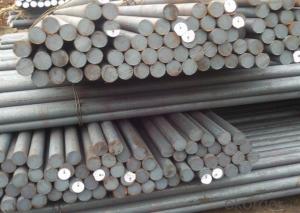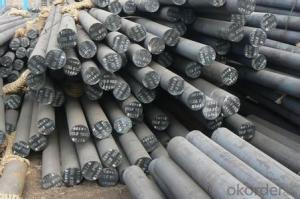Q235 stainless round steel bar for construction
- Loading Port:
- Tianjin
- Payment Terms:
- TT OR LC
- Min Order Qty:
- 25000 m.t.
- Supply Capability:
- 10000 m.t./month
OKorder Service Pledge
OKorder Financial Service
You Might Also Like
Usage and Applications
These steels are used for ball and roller bearing applications and are comprised of low carbon steels and high carbon through harden able steel.
First the famous 1C-1.5Cr steel from which the majority of bearings are made. Its structure is apparently well-understood and the focus is on purity in order to avoid inclusions which initiate fatigue during rolling contact. Then there is the M50 steel and its variants, from which bearings which serve at slightly higher temperatures in aeroengines are manufactured, based on secondary-hardened marten site.
Tapered roller bearing are generally used to support combined load mainly consisting of radial load. Their cups are separable for easy assembling ,During mounting and using, radial clearance and axial clearance can be adjusted and preloaded mounting can be made.
Packaging & Delivery
Packaging Detail: ASTM 52100 Steel in seaworthy packing or on customer request; Packed in bundles with standard export sea-worthy package or as customer require
Delivery Detail: 45 days after confirmed
Trade terms: FOB, CFR, CIF ou as customer's required
MOQ: 25 tons or at customer's demands. If the quantity is good, the price will be better.
Production Flow of Chinese Standard Round Bar
1. The common processes are preheated forging quenching, dual refinement solution process, cooling quenching and isothermal quenching. We use heat treatment for dual refinement solution process.
2. Material prepare (billet) — heat up — rough rolling — precision rolling — cooling — packing — storage and transportation
Characteristics of Chinese Standard Round Bar
1. The steel in which the main interstitial alloying constituent is carbon in the range of 0.12–2.0%.
2. As the carbon percentage content rises, steel has the ability to become harder and stronger through heat treating; however it becomes less ductile.
3. Quality should be in conformity with the specification of the manufacturer. Quantity and packing conditions should be in conformity with the term in the contract.
4. Regardless of the heat treatment, higher carbon content reduces weld ability. In carbon steels, the higher carbon content lowers the melting point.
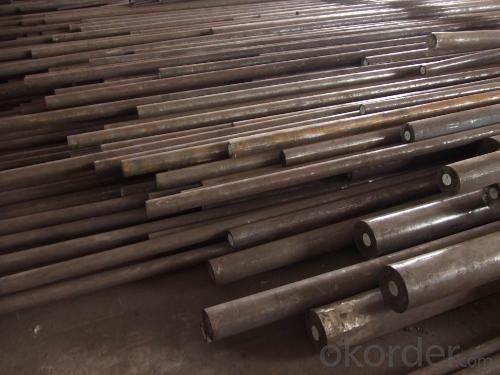
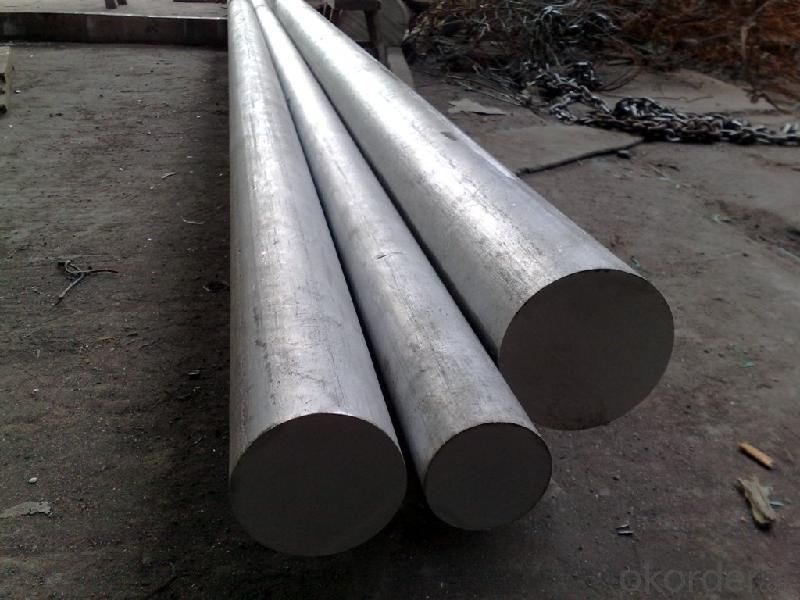
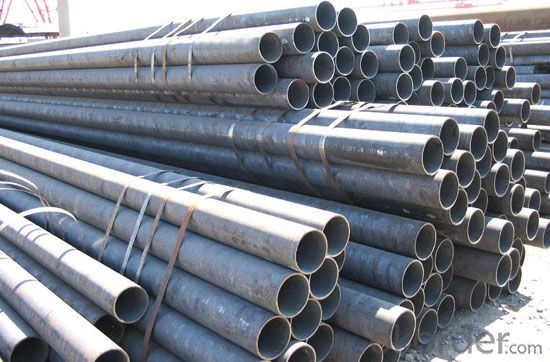
- Q:Can steel round bars be used for making propeller shafts?
- Yes, steel round bars can be used for making propeller shafts. Steel is a common material choice for propeller shafts due to its strength, durability, and resistance to corrosion. The round shape of the steel bar allows for efficient transfer of rotational energy, making it suitable for propeller shafts in various applications.
- Q:Is round steel bar round steel?
- NoRound steel bars refer to hot rolled round steel bars for reinforced concrete. Round bars include high-quality carbon structural steel, round steel, ordinary carbon structural steel round bars, steel bars for prestressed concrete, etc.. Although the shape is round, but the material is different, so steel and round bar is two yards.
- Q:Can steel round bars be used for making agricultural equipment or machinery?
- Yes, steel round bars can be used for making agricultural equipment or machinery. Steel is a commonly used material in the construction of such equipment due to its high strength, durability, and resistance to wear and tear. Steel round bars can be used to manufacture components like axles, shafts, handles, and structural supports, providing the necessary strength and reliability required for agricultural applications.
- Q:What is the tensile strength of round steel bars of diameter 28?
- The tensile strength of round steel bars of diameter 28 is 27079.36~33849.2 kg. It is explained as follows: the material of rebar is generally Q235-A carbon structural steel, its yield strength is 235 MPa, tensile strength is 441~550 MPa, and it is 44~55 kg / mm2. The cross-sectional area of 28 mm in diameter is about 615.44 mm2, and its tensile strength is about 27079.36~33849.2 kg.
- Q:What are the different types of steel round bar alloys?
- There are several different types of steel round bar alloys, including carbon steel, stainless steel, alloy steel, and tool steel.
- Q:What is the difference between a hot rolled and a precision ground steel round bar?
- A hot rolled steel round bar and a precision ground steel round bar differ primarily in their manufacturing processes and resulting surface finish. Hot rolled steel round bars are produced by heating the steel billet or ingot to high temperatures and then passing it through a series of rollers to achieve the desired shape and size. This process results in a rougher surface finish with visible mill-scale or oxide layers. The hot rolling process also allows for variations in size and shape, making it a more cost-effective option for producing steel round bars in large quantities. On the other hand, precision ground steel round bars undergo a more refined and controlled manufacturing process. After the initial hot rolling, the bar is then ground to achieve a smooth and consistent surface finish. Precision grinding removes the mill-scale and oxide layers, resulting in a more polished appearance. This process also ensures a tight dimensional tolerance and improved straightness of the round bar. The choice between a hot rolled and a precision ground steel round bar depends on the specific application requirements. Hot rolled round bars are typically used in applications where surface finish is not critical, such as structural components, machinery parts, or construction materials. Precision ground steel round bars, on the other hand, are utilized in applications where a smooth surface finish, precise dimensions, and tight tolerances are necessary, such as in the manufacturing of precision tools, machinery components, or in industries like aerospace or automotive. In summary, the main difference between a hot rolled and a precision ground steel round bar lies in their manufacturing processes and resulting surface finish. Hot rolled round bars offer cost-effectiveness and versatility, while precision ground round bars provide a smoother surface finish, tighter tolerances, and improved dimensional accuracy for more demanding applications.
- Q:What are the advantages of using nickel-chromium-aluminum alloy steel round bars?
- Nickel-chromium-aluminum alloy steel round bars offer numerous benefits. Firstly, they possess exceptional corrosion resistance, making them ideal for use in harsh environments or industries where corrosion is a concern. This resistance to corrosion prolongs the lifespan of the round bars, reducing maintenance and replacement expenses. Secondly, these round bars are known for their high strength and durability, making them suitable for applications that involve heavy loads or high temperatures. Their strength also enhances structural stability, making them a dependable option for construction projects and industrial applications. Additionally, this alloy steel demonstrates excellent thermal stability, allowing it to maintain its shape and mechanical properties even under elevated temperatures. This attribute is particularly advantageous in industries such as aerospace, automotive, and power generation, where high temperatures are prevalent. Furthermore, nickel-chromium-aluminum alloy steel round bars offer good formability and machinability, facilitating easy fabrication and customization. This versatility allows for the production of intricate shapes and designs, making them adaptable for various manufacturing processes. Lastly, this alloy steel is recognized for its resistance to oxidation and scaling at high temperatures. This makes it suitable for applications involving exposure to extreme heat or rapid temperature changes, such as in furnaces or heat exchangers. In conclusion, the benefits of utilizing nickel-chromium-aluminum alloy steel round bars include exceptional corrosion resistance, high strength and durability, thermal stability, formability, and resistance to oxidation. These qualities make it a preferred choice for a wide range of industries, ensuring reliable performance and longevity in various applications.
- Q:What are the different types of corrosion-resistant steel round bars?
- There are several different types of corrosion-resistant steel round bars available in the market. Some of the commonly used types include: 1. Stainless Steel Round Bars: Stainless steel is a popular choice for corrosion-resistant applications due to its high resistance to rust and corrosion. It contains chromium, which forms a protective oxide layer on the surface of the steel, preventing further corrosion. 2. Duplex Stainless Steel Round Bars: Duplex stainless steel is a type of stainless steel that contains a balanced combination of austenite and ferrite microstructures. This gives it excellent corrosion resistance, high strength, and good weldability. 3. Nitronic Stainless Steel Round Bars: Nitronic stainless steel is a high-performance alloy that offers superior corrosion resistance, high strength, and good ductility. It contains nitrogen, which enhances its resistance to pitting and crevice corrosion. 4. Alloy Steel Round Bars: Alloy steel is a type of steel that is alloyed with various elements to improve its properties. Some alloy steels, such as corrosion-resistant alloys (CRA), are specifically designed to resist corrosion in harsh environments. These alloys typically contain elements such as chromium, nickel, and molybdenum. 5. Aluminum Round Bars: While not technically steel, aluminum round bars are often used in applications where corrosion resistance is essential. Aluminum forms a protective oxide layer on its surface, which helps prevent corrosion. It is particularly suitable for applications where weight is a concern. 6. Copper-Nickel Round Bars: Copper-nickel alloys, such as Cu-Ni 90/10 and Cu-Ni 70/30, are widely used in marine and offshore applications due to their excellent resistance to seawater corrosion. These alloys have high strength, good ductility, and exceptional resistance to biofouling. These are just a few examples of the different types of corrosion-resistant steel round bars available. The choice of material depends on the specific application requirements, environmental conditions, and budget considerations. It is important to consult with a materials engineer or specialist to select the most suitable corrosion-resistant steel round bar for a particular application.
- Q:How do you determine the hardness of a steel round bar?
- The hardness of a steel round bar can be determined through various methods, including hardness testing techniques such as Rockwell, Brinell, or Vickers testing. These tests involve applying a specific amount of pressure or indentation on the surface of the steel bar and measuring the resulting indentation size. The hardness value obtained from these tests is then used to determine the material's resistance to deformation and its ability to withstand wear and tear.
- Q:What are the different heat treatment processes used for steel round bars?
- There are several heat treatment processes that are commonly used for steel round bars to enhance their mechanical properties and improve their overall performance. These processes include annealing, normalizing, quenching, tempering, and case hardening. 1. Annealing: This process involves heating the steel round bars to a specific temperature and then cooling it slowly to relieve internal stresses and improve its ductility. Annealing also refines the grain structure of the steel, making it softer and more workable. 2. Normalizing: Similar to annealing, normalizing involves heating the steel round bars to a specific temperature, but in this case, it is cooled in still air. Normalizing helps to refine the grain structure and improve the steel's mechanical properties, such as strength and toughness. 3. Quenching: Quenching is a rapid cooling process that involves immersing the steel round bars in a quenching medium, such as oil, water, or polymer. This process is used to achieve high hardness and strength by transforming the steel's microstructure, known as martensite formation. However, quenching can also make the steel more brittle, so it is often followed by tempering. 4. Tempering: Tempering is a heat treatment process that involves reheating the quenched steel round bars to a specific temperature and then cooling it slowly. This process helps to reduce the brittleness caused by quenching and improves the steel's toughness and ductility. The temperature and duration of tempering can be adjusted to achieve the desired mechanical properties. 5. Case hardening: Case hardening is a surface heat treatment process used to increase the hardness and wear resistance of the steel round bars. It involves introducing carbon or other alloying elements to the surface of the steel and then heating it to a specific temperature. This process forms a hardened outer layer while maintaining a tough core. These different heat treatment processes provide steel round bars with a wide range of mechanical properties and performance characteristics, allowing them to be used in various applications, including automotive, construction, manufacturing, and aerospace industries. The specific heat treatment process selected depends on the desired properties, the steel composition, and the intended application of the round bars.
1. Manufacturer Overview |
|
|---|---|
| Location | |
| Year Established | |
| Annual Output Value | |
| Main Markets | |
| Company Certifications | |
2. Manufacturer Certificates |
|
|---|---|
| a) Certification Name | |
| Range | |
| Reference | |
| Validity Period | |
3. Manufacturer Capability |
|
|---|---|
| a)Trade Capacity | |
| Nearest Port | |
| Export Percentage | |
| No.of Employees in Trade Department | |
| Language Spoken: | |
| b)Factory Information | |
| Factory Size: | |
| No. of Production Lines | |
| Contract Manufacturing | |
| Product Price Range | |
Send your message to us
Q235 stainless round steel bar for construction
- Loading Port:
- Tianjin
- Payment Terms:
- TT OR LC
- Min Order Qty:
- 25000 m.t.
- Supply Capability:
- 10000 m.t./month
OKorder Service Pledge
OKorder Financial Service
Similar products
New products
Hot products
Related keywords


